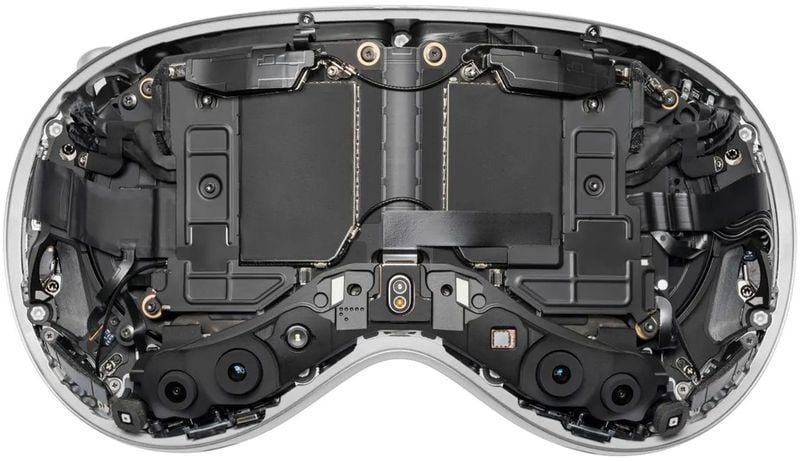The curtains have been stripped and chips exposed as iFixit performs their customary inaugural teardown, this time on Apple’s first ever VR headset – the Apple Vision Pro.
Their analysis grants an exclusive peak under the hood at the bleeding edge tech and design innovations powering Apple’s ambitions to define the next generation of immersive mixed reality.
From custom silicon to precision eye tracking sensors, what secrets hide behind the secrecy as we examine this glimpse into the apple VR’s foundation?
M2 Chip: Brains of the Operation
Serving as the processing workhorse within the Vision Pro, Apple’s latest homegrown system-on-a-chip makes an appearance.
The inclusion of the M2 mirrors the chip choice found inside Apple’s newest MacBooks, promising significant horsepower for smooth graphics, multitasking and future proofing.
For a headset expected to retailing around $3000, housing the company’s second most advanced mobile silicon aims to justify the proposition for early adopters and professionals.
12 Cameras for Unprecedented Eye Tracking
But while the M2 delivers the baseline brawn, some of the most intriguing revelations surround the Apple Vision Pro’s elaborate eye tracking implementation.
Enabled by an astounding array of 12 embedded cameras plus 6 supporting sensors, Apple has engineered unparalleled ocular awareness into its headset.
The goals behind this eye tracking showcase include foveated rendering for boosted graphic fidelity concentrating power where users directly look.
Additionally, advanced iris scanning could enable authentication for seamless security and profiles following users across future Apple VR and AR devices as the ecosystem matures.
Dual Micro-OLED Displays
Serving as the literal lenses into Apple’s VR environments, iFixit notes the inclusion of dual micro-OLED displays boasting exceptional colors, contrast and per pixel dimming control.
These compact high density panels surpass any previous Oculus or HTC VR headset, promising stunning lifelike visual immersion amplified by the Vision Pro’s speedy eye tracking capabilities.
And by utilizing OLED compared to LCD or mini-LED options, Apple underscores deep blacks crucial for realistic VR without light contamination.
Both display and silicon selections align with Apple’s VR ethos – deliver category redefining fidelity but also richness through enabling users expanded control and personalization.
Design Decisions Promoting Comfort
Transitioning from internal tech advancements to external industrial design, the Apple Vision Pro’s materials also showcase meticulous attention towards user experience – specifically wearing comfort.
Utilizing light, breathable fabrics lining every contact point, Apple departs from traditional VR headset hunky designs.
This allows not just superior temperature regulation but also weight distributions avoiding pressure points during lengthy immersion sessions.
Once again, Apple’s knack for sweating details surrounding material science ads an underappreciated comfort differentiator to ensure sustained enjoyment free from physical distractions.
Modularity for Long Term Support
Pivoting to battery design, Apple again favors strategic foresight bolstering sustained usability.
Inside the teardown, iFixit notes a modular, user replaceable battery segments instead of an permanently encased single cell solution.
This modularity allows Apple to potentially increase capacities with later generation component upgrades.
Additionally, replaceability by either consumers or through AppleCare support means the Vision Pro can conceivably deliver improved power autonomy as innovations emerge across Apple’s VR roadmap.
Building devices enabling upgrades epitomizes Apple’s shifting sustainability initiatives – supporting products across longer lifespans while minimizing eWaste.
Software Experience Still the Great Unknown
While the hardware itself impresses with custom technologies aligning towards immersion and longevity goals, questions linger around the Vision Pro’s platform software capabilities.
Will Apple deliver a robust library of environments and experiences realizing VR’s promise beyond hardware specs?
Equally, how seamlessly will experiences transition between the rumored follow-up augmented reality glasses project indicating blended VR/AR abilities?
If the software ecosystem mismatch hardware innovations, the Vision Pro risks struggle emulating the App Store’s profound success catalyzing iPhone popularity.
However, Apple’s envisioning prowess means they may shock doubters and unveil VR software paradigm shifts moving the needle akin to multi-touch on smartphones.
The Vision Pro As First Step Into Next Frontier
As Apple’s inaugural dedicated VR entry, the Vision Pro by most accounts focuses on laying robust technological and experiential foundations.
Thanks to insights via the iFixit teardown, we find custom processor advancements merging with elaborate sensor arrays and ergonomic considerations contributing towards category redefining immersion.
However fulfilling the long term potential depends greatly on software ecosystem nurturing to inspire developers towards creating category defining new digital worlds.
In many ways, the Vision Pro sets the stage for Apple to excel across VR like they have previously with smartphones, tablets and wearables.
But for now, glimpses behind the curtain illustrate immense ambitions backed by custom engineering might pointing towards the next monumental shift for Apple’s future.










Add Comment